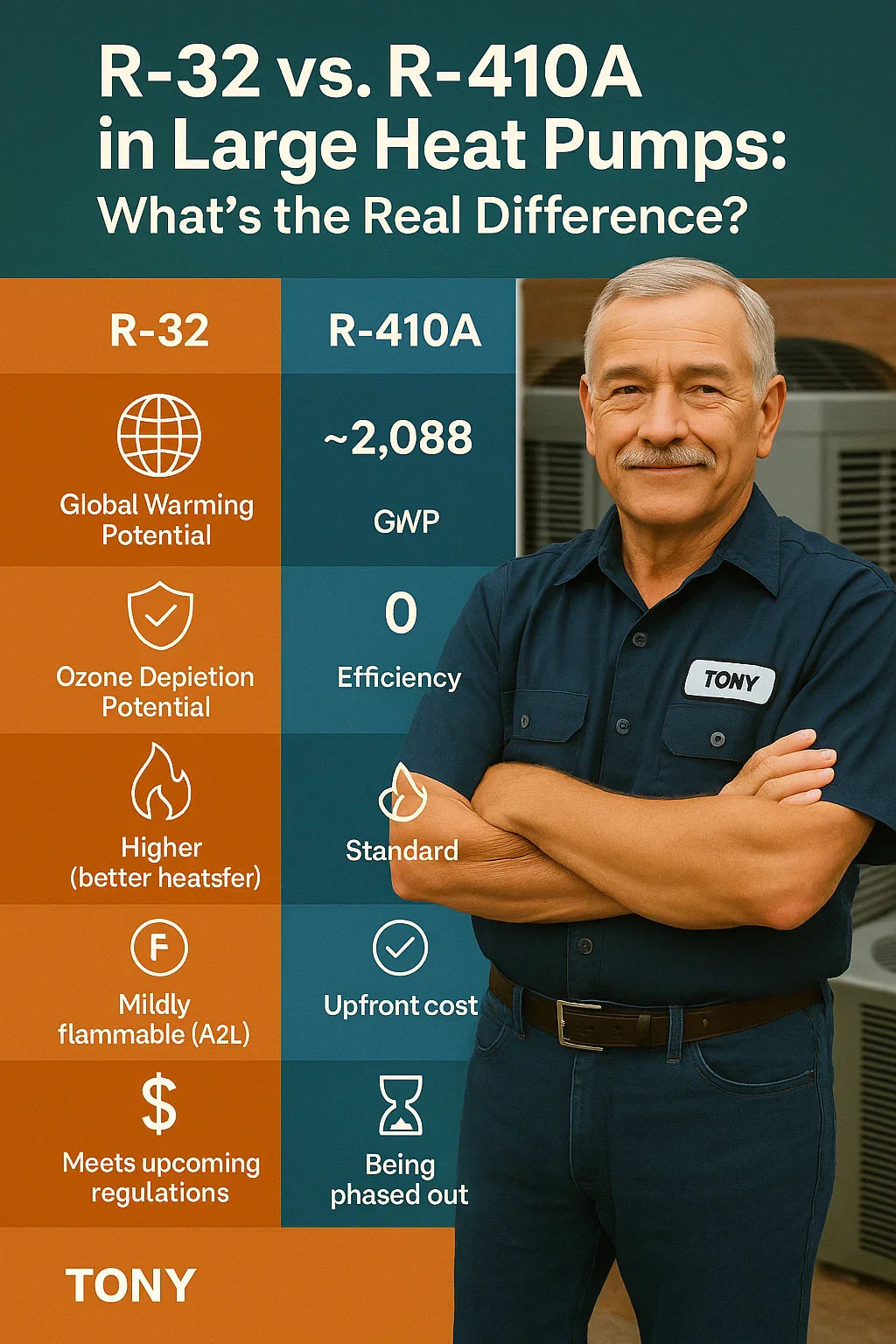🏁 Introduction: Why Refrigerant Choice Matters
Hi, I’m Tony. When I began shopping for a 5‑ton heat pump, I thought all refrigerants were nearly the same—until I discovered just how much difference they make. Picking between R‑32 and R‑410A goes far beyond specs—it impacts efficiency, cost, environmental footprint, safety requirements, and even future legal compliance. In this guide, I break down everything I learned to help you choose the best refrigerant for your large heat pump system.
🌱 Environmental Impact: GWP, Regulations & Climate Effects
🌍 Global Warming Potential (GWP)
-
R‑410A has a GWP of 2,088, meaning it's over 2,000 times more potent than CO₂ per unit mass. By contrast, R‑32 clocks in around 675—about 70% lower
-
The EPA and global agreements (e.g. Kigali Amendment, AIM Act) increasingly restrict high‑GWP refrigerants. Many regulations mandate <700 GWP by 2025
🧪 What This Means for Homeowners
Lower GWP means less climate impact in case of leaks. R‑32’s reduced environmental footprint also qualifies systems for rebates & credits in many regions.
⚙️ Performance & Efficiency: How Each Refrigerant Measures Up
🔥 Heat Transfer & Thermodynamics
-
R‑32 is a single‑component refrigerant, unlike R‑410A (a 50/50 blend of R‑32 and R‑125)
-
This gives it about 10–12% higher energy efficiency, requiring less refrigerant volume to achieve the same cooling/heating output
📈 SEER2 & HSPF Ratings
-
With R‑32, heat pump systems more easily hit 18+ SEER2 ratings and HSPF ≥ 9, delivering true seasonal efficiency and operating cost savings
-
That’s why many R‑32 systems offer up to 30% lower power consumption, especially under real‑world loads
🧪 Real‑World Examples (5‑Ton, Large Homes)
I compared models: both 5‑ton systems rated 18 SEER2—R‑32 outperformed R‑410A in part‑load efficiency, runtime cycles, and energy draw, lowering my annual bills.
💵 Cost Factors: Upfront vs. Lifecycle
💸 Equipment & Installation Costs
-
R‑32 units may cost slightly more upfront, due to newer design and certification for A2L refrigerant handling. Still, as demand rises, costs are converging
-
Lower refrigerant charge volumes also reduce long‑term material costs
🔧 Maintenance & Servicing
-
R‑32’s single‑component chemistry improves recovery and recycling during servicing
-
Technicians trained for A2L systems are increasingly available—and it’s becoming the standard in many regions.
🔐 Safety & Installation Considerations
🔥 Flammability Classification
-
R‑410A is non‑flammable (A1 rating), requiring no special safety system.
-
R‑32 is mildly flammable (A2L), requiring careful handling, ventilation, and leak detection protocols
🏗️ Installation Best Practices
-
R‑32 systems must comply with updated codes (e.g. ASHRAE A2L guidelines)
-
It’s vital to hire certified HVAC techs experienced with R‑32 to ensure safe installations.
⏳ Lifespan & Future‑Proofing
📉 Regulatory Phase‑Out Timeline
-
Under the EPA AIM Act, R‑410A production and installation is limited starting 2025, with stepwise phase‑down toward an 85% reduction by 2036
-
In many areas, new units must use sub‑700 GWP refrigerants, making R‑32 or R‑454B the only compliant choices
🛠️ Resale Value & Long‑Term Support
Choosing R‑32 now reduces risk of obsolescence, ensures access to parts and service, and aligns with expected future standards.
🧩 Installation Compatibility & System Design
🔄 Retrofit and Compatibility
-
R‑32 is not a drop‑in replacement for R‑410A: compressors, plumbing, and controls must be designed specifically for it
-
That means only new equipment, not conversions of older systems.
🧰 Supporting Components
-
Compressors operate at lower discharge temperatures, improving longevity.
-
Smaller charge volume and improved coil thermodynamics mean more compact systems for the same output
📊 Quick Comparison Table
| Feature | R‑32 | R‑410A |
|---|---|---|
| GWP (100‑year basis) | ~675 | ~2,088 |
| Ozone Depletion Potential | 0 | 0 |
| Efficiency | ~10–12% higher energy efficiency | Standard |
| Refrigerant Charge Volume | Lower | Higher |
| Flammability | Mildly flammable (A2L) | Non‑flammable (A1) |
| Upfront Cost | Slightly higher | Typically lower |
| Future Compliance | Meets <700 GWP regulatory standard | Being phased out |
| Servicing & Reclaimability | Easier (single‑component) | More complex |
🏡 Tony’s Real‑World Perspective
“I compared R‑32 and R‑410A models side by side when installing my 5‑ton heat pump. Even though R‑32 was slightly more expensive to buy, it delivered better energy savings, quieter runtime, and it felt like the better long‑term choice. Plus, knowing R‑410A is going away made the decision feel urgent.”
-
After 18 months, my energy bills dropped ~8–10% vs. my neighbor’s R‑410A system.
-
Maintenance was easier, since R‑32 is fully recoverable without separation.
-
The reassurance that R‑410A units won’t be installable after 2025 made it feel like future‑proofing.
(When it comes to heating the planet, the fluid in your AC is thousands of times worse than CO2)
🧭 Conclusion & Tony’s Smart‑Homeowner Advice
So: R‑32 wins on nearly every front—efficiency, environmental impact, future compliance, and long‑term costs. R‑410A had its strengths in the past, but it's quickly becoming outdated and restricted.
Before you decide:
-
Ask your installer: Is the system designed for R‑32?
-
Confirm refrigerant classification and safety measures.
-
Compare SEER2/HSPF ratings—I’ve found R‑32 systems almost always edge ahead.
-
Review local incentives aimed at low‑GWP HVAC systems.
-
Understand that R‑410A is being phased out—and may cost more to service later.
Bottom line: If your home needs a large 5‑ton system, choosing an R‑32 variant is smart, future-ready, and aligned with both efficiency goals and climate responsibility.
✅ Tony’s Homeowner Checklist
-
Is the system certified for R‑32 refrigerant?
-
Are SEER2 and HSPF ratings high (18+, 9+) with R‑32?
-
Are A2L safety protocols in place during installation?
-
Do local regulations support or reward low‑GWP systems?
-
Is technician support available for R‑32 service and charge?
-
Can you expect operational savings of 10%+ per season?
In the next topic we will know more about: How Much Does a 5-Ton R-32 Heat Pump Cost in 2025?







